[Thanks to Jonathan Ford, Secretary of the Athenæum Club, for generously sharing John Kenworthy-Browne's work with the readers of the Victorian Web. George P. Landow adapted A Temple of British Worthies for the Web.]
Mostly in the Drawing Room and Library. All are of plaster (gesso) unless otherwise stated [JK-B].
1. Edmund Burke (1729-1797), after John Hickey (1751-1795)
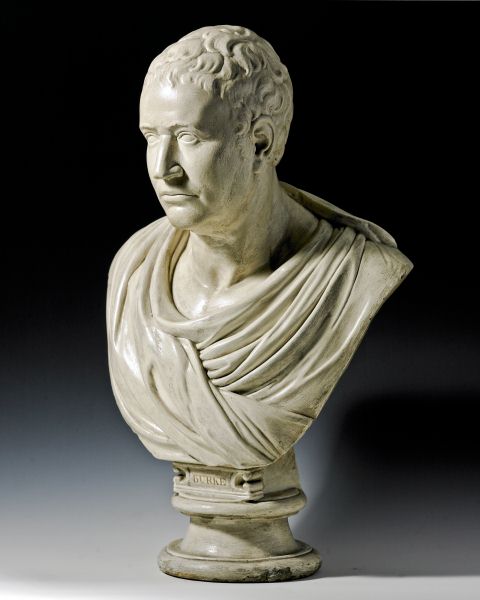


Presented in January 1830” by Thomas Haviland Burke of Lincoln’s Inn (nephew of the sitter). Tait, no. 117, illustration on p. xxi. The Committee recorded the gift of this plaster bust on 26 January 1830. Sarti’s 1830 account includes the entry ‘putting pedestal to the Bust of Burke, 7s.’ The painted name ‘Burke’ in black letters was inscribed” by Sarti.
John Hickey, born in Dublin, worked in London where he was encouraged” by his compatriot Edmund Burke. The bust of Burke was exhibited at the Royal Academy in either 1785 or 1791. Two marble busts were made; the first, obviously Burke’s own copy, was presented to the British Museum” by T H Burke, the Club’s doner, but it was destroyed” by enemy action in 1941. This will have been the bust from which the present cast was made. The other was ordered” by the 4th Earl Fitzwilliam, who paid Hickey 50 guineas on 25 May 1789, for the Mausoleum at Wentworth Woodhouse, Yorkshire (D. Wilson in The British Art Journal IV.3, 2003, 68). Recently it was replaced” by a plaster cast. There is a nineteenth-century marble copy in Trinity College Library, Dublin.
The Committee thanked the donor for his gift on 26 January 1830. In 1833, Burke was among fourteen plaster busts in the Drawing Room and, along with the rest of the busts, it was moved to the basement in 1856. Ten busts were set up in the Drawing Room in 1920 but Burke remained in the basement until after 1939. Unlike the Worthies on the bookcases this bust has retained Sarti’s 1830 socle, with the name in black, and what looks like original surface paint.
2. David Garrick (1717-1779)



Supplied” by P Sarti, 1830. Tait, no. 313.
The bust is attributed to John III Van Nost (d. 1780) on the slender evidence of J.T. Smith, who records this exchange:
[Macklin loquitur:] ‘Do I not see your bust of Garrick in every barber’s shop-window, as a block for wigs?’ ‘No’, answered Nollekens, ‘it is not my bust; it is Van Nost’s.’ (J.T. Smith, Nollekens and his Times, 1828, II, 275).
At the Garrick Club a plaster bust was presented” by Theodore Hook in 1835 (or 1841: Ashton, no. S11). It is identical to the Athenæum bust, but it lacks the three buttons on the coat. Wedgwood made reduced and simplified busts in his ‘basalt ware’.
3. William Harvey (1578-1657), after Peter Scheemakers (1691-1781)

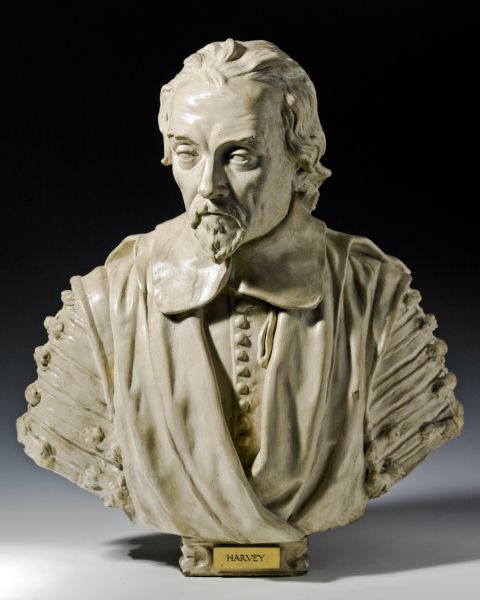

Supplied” by P. Sarti, 1830. Tait, no. 386.
Dr Harvey, physician, discovered the circulation of the blood. The marble bust was commissioned” by Dr Richard Mead, who in 1739 presented it to the Royal College of Physicians. Scheemakers based his portrait on an oil painting attributed to Wilhelm van Bemmel, which also belonged to Dr Mead (now Hunterian Museum, Glasgow; the portrait was engraved” by Houbraken in 1739). This is one of the sculptor’s best works, and Rupert Gunnis thought it was” by Roubiliac (Ingrid Roscoe in Walpole Society LXI, 1999, 261). There are two plaster casts at the Royal College of Physicians.
4. Dr Samuel Johnson (1709-1784), after Joseph Nollekens R.A. (1737-1823)

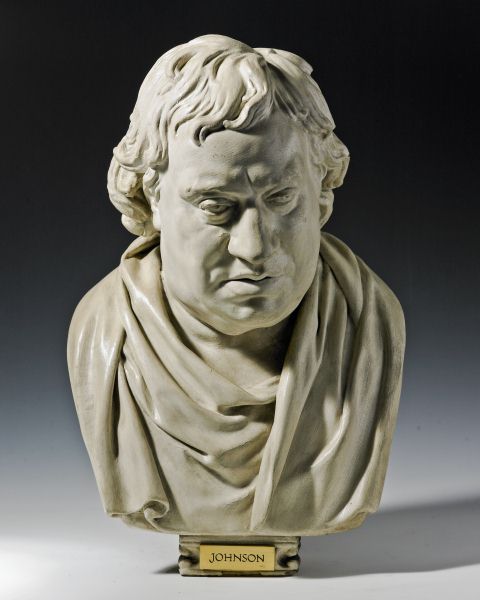
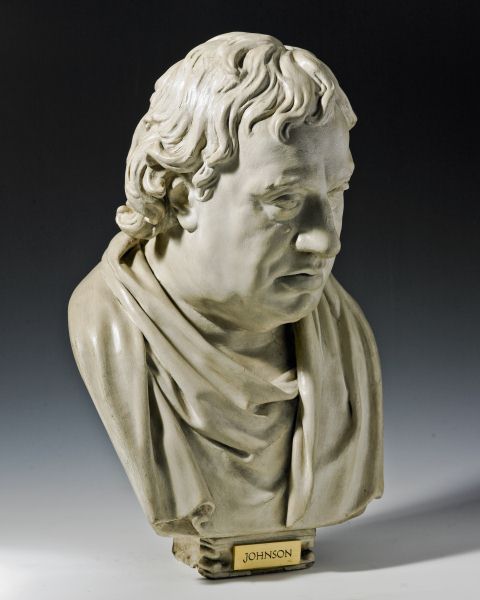
Supplied” by P. Sarti, 1830. Tait, no. 468.
Dr Johnson was a friend of Saunders Welch, father-in-law of the sculptor Nollekens, and he sat for the portrait at the sculptor’s request. Nollekens made the bust for exhibition at the Royal Academy (1777, no. 254) and for his reputation, and he never copied it in marble. Chantrey later considered it to be Nollekens’s finest portrait bust, but Johnson did not care for the natural style of the ‘antique’ locks; nevertheless, he gave plaster casts of it to his friends. eighteenth-century century casts are rare. There are two (one ‘bronzed’) at Johnson’s Birthplace Museum, Lichfield, and another at the Yale Center for British Art, USA. An early cast in lead is in the Victoria and Albert Museum.
Marble versions at the National Portrait Gallery, London, and Westminster Abbey were made” by E H Baily, and others exist in country house libraries.
After Nollekens’s death in 1823, Alexander Goblet, his studio manager, sold moulds of some forty two of his busts, including those of Johnson and Mansfield (number 7), to the cast maker and phrenologist James Deville (1777-1846) who earlier had been employed” by Nollekens. Sarti may have used those same moulds.
5. John Locke (1632-704)

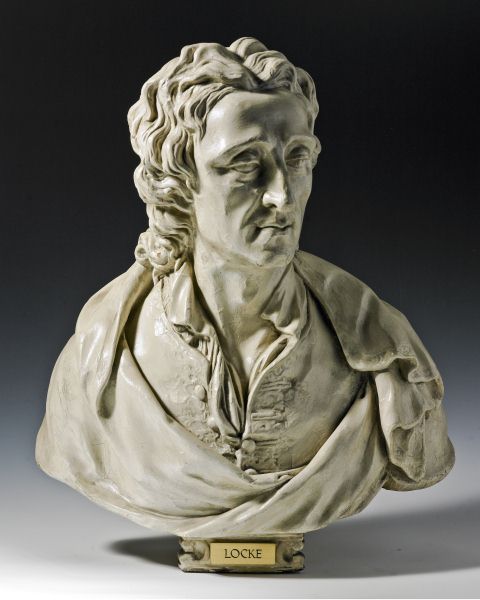

Supplied” by P. Sarti, 1830. Tait, no. 535.
A number of examples of this portrait are known, in both plaster and marble. The earliest is the plaster in the Wren Library, Cambridge (1750s). A splendid bronzed plaster of the 1770s is at West Wycombe Park, Buckinghamshire and a white plaster, signed” by Sarti, is at Wimpole Hall, Cambridgeshire. A fine eighteenth-century example in bronze is currently (2011) on the art market. Except for the Wimpole bust, none is signed or dated.
The bust can be attributed to John Cheere and it seems to have been based on an engraving” by Vertue (1713) after a famous and much copied oil portrait” by Kneller (see below). John Cheere also made a statuette of Locke (Kirkleatham, Yorkshire), which is signed and dated 1749.
The present portrait has generally, but incorrectly, been assumed to be based on Rysbrack’s terracotta bust (dated 1755; Welbeck Abbey, Notts) which itself was a model for his statue (1755-57) at Christ Church Library, Oxford. In fact, the two busts were, however, independent and the present model appears to be the earlier” by a few years. Two other sculptured portraits of Locke are the busts” by Guelfi (marble, 1732, Kensington Palace), and Scheemakers (marble, 1745, Trinity College Library, Dublin). All of these images were evidently derived from Kneller’s 1698 oil portrait (formerly Walpole collection but now at the Hermitage, St Petersburg) or from copies or engravings made after it.
6. John Milton (1608-1674)

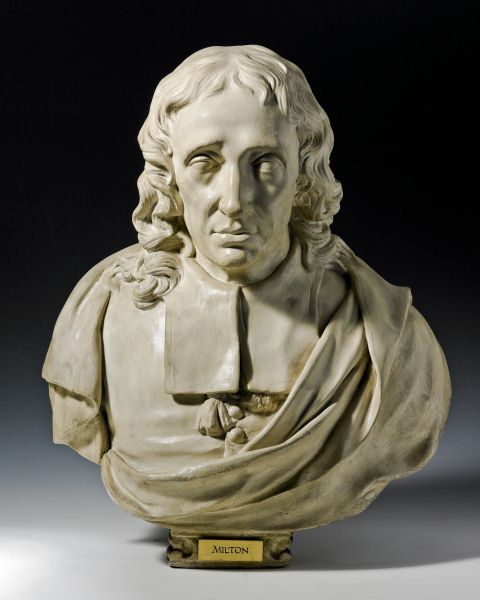

Supplied” by P. Sarti, 1830. Tait, no. 601.
Like the busts of Shakespeare and Locke, this portrait of Milton first appears in plaster at the Wren Library, Cambridge, in the 1750s and like them we attribute it to John Cheere. There is a fine bronzed bust at West Wycombe Park, Buckinghamshire, and a later one signed” by Sarti at Wimpole Hall, Cambridgeshire. The model was probably based on a famed marble bust” by Rysbrack (1739, Westminster Abbey, or Stourhead, Wiltshire), or an engraving” by Vertue.
Evidently the present model remained popular for some time. At St Paul’s School, London, there is a good marble copy signed” by Matthew Noble and dated 1866, and the Club possesses an unsigned marble, but of no great quality (no. 21).
7. William Murray, 1st Earl Of Mansfield (1705-1793), after Joseph Nollekens RA (1737-1823)

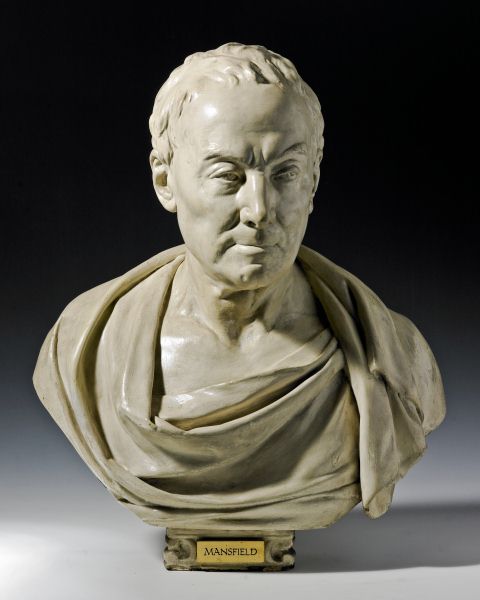

Supplied” by P. Sarti, 1830. Tait, no. 601.
The bust” by Nollekens of the eminent judge is at the Iveagh Bequest, Kenwood, and a replica at Belvoir Castle. Both are dated 1779. The present plaster is a cast from another bust” by Nollekens, undated but certainly authentic, at Trinity Hall, Cambridge, which has slightly different drapery. J T Smith wrote that the moulds of Nollekens’s busts of Johnson (No 4) and Mansfield were sold in 1823 to James Deville, plaster worker and phrenologist in The Strand, and Sarti may have used the same moulds.
8. Sir Isaac Newton (1642-1727), after L.-F. Roubiliac (?1705-1762)



Supplied” by P. Sati, 1830. Tait, no. 628.
This cast was made from the marble bust” by Roubiliac at the Wren Library, Cambridge, which is signed and dated 1751. Another marble bust” by Roubiliac, at the Royal Society, London, differs in certain details of drapery.
The bronzed plaster bust (1770s) at West Wycombe Park, Buckinghamshire, is a different portrait, having been cast from a bust” by Rysbrack.
9. Sir Joshua Reynolds (1723-1792), after Giuseppe Ceracchi (1751-1801)



Acquired before 1894; provenance unknown. Tait, no. 760.
This must have been cast from Ceracchi’s bust of Reynolds in terracotta, dated 1778, which had been presented to the Royal Academy in 1810. Sarti made new moulds of the bust, but was not allowed to keep them for his own use. The tunic and cloak were added to the portrait” by Sarti, to make the format similar to the others.
Ceracchi’s terracotta was apparently destroyed (The Age of Neo-Classicism, Council of Europe Exhibition Catalogue, London 1972, no. 335). The Royal Academy now possesses an undated marble version of the bust, signed Cirachi sculpsit Roma, which was presented” by Lord Taunton in 1851. On the cast in the Octagon at the Burlington House (built 1868), the pinned cloak is different from the marble, which suggests that it too had been made from the lost terracotta.
10. Sir Walter Scott (1771-1832), after Sir Francis Chantrey R.A. (1781-1841)
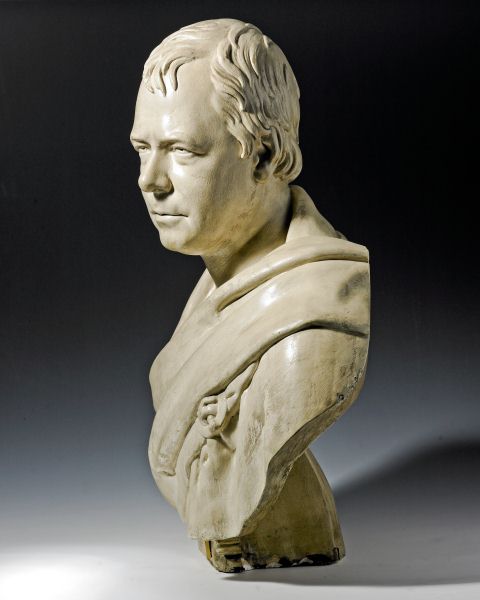
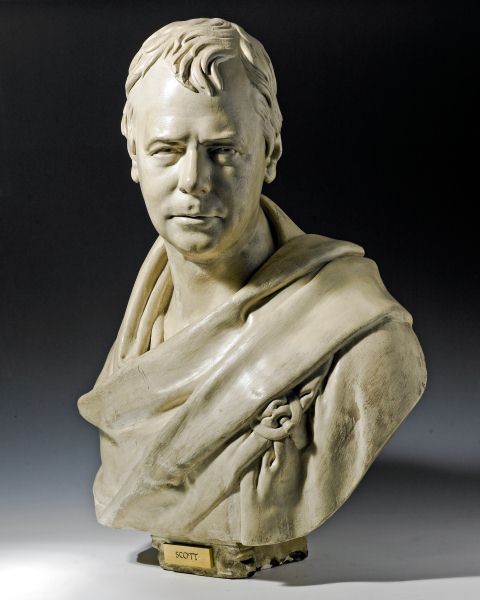

Acquired before 1894; provenance unknown. Tait, no. 760.
Walter Scott was a member of the Club. Chantrey made his famous bust in 1828 and presented it to the sitter. Four marble replicas were subsequently made, the first two for the Duke of Wellington and Sir Robert Peel. It was a popular portrait and there are many plaster casts and marble copies.
he Athenæum’s bust lacks the incised pattern on the plaid. The hollow back was smoothed over, indicating a date of manufacture later than Sarti’s busts of the 1830s. It is first recorded at the Club in the inventory of 1894.
11. William Shakespeare (1554-1616)
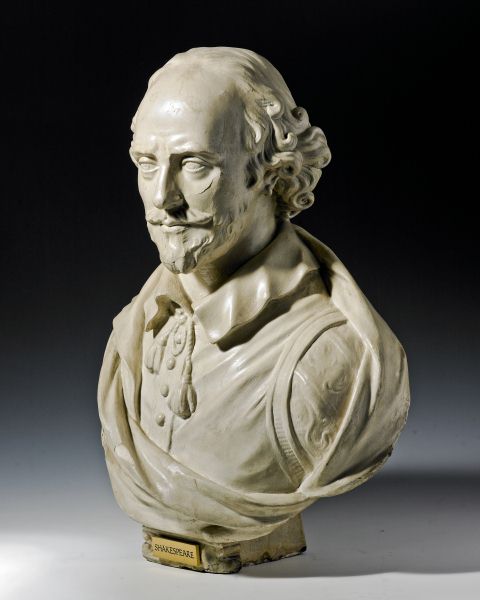

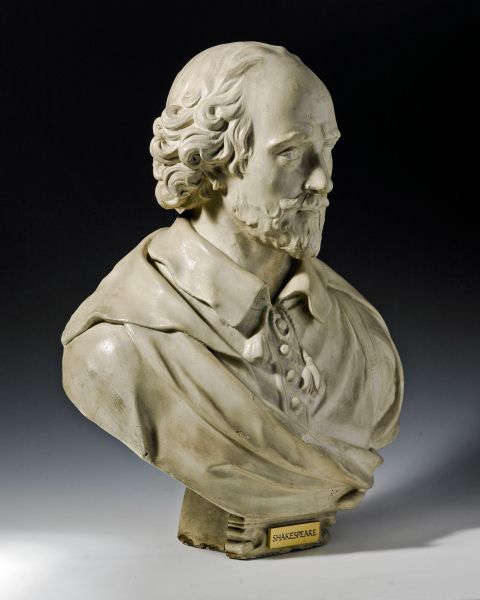
Supplied” by P. Sarti, 1830. Tait, no. 773.
We may attribute the bust to John Cheere. It seems to be based on the famous monument” by Scheemakers (1745) in Westminster Abbey, made during the eighteenth-century revival of Shakespeare. The earliest known example of the present model is in the Wren Library, Cambridge. There is a marble, unsigned but circa 1800, in the Royal Collection at Windsor.
A plaster bust presented to the Garrick Club in 1834-36 bears the impressed signature of ‘Shout’ (Ashton, no. S.30). Robert Shout of Holborn (active 1778-1827) made marble monuments and plaster casts. The bust in the Garrick is thought to be circa 1806. All the known busts except that in the Athenæum have incised brocading on the left shoulder.
Other sections of A Temple of British Worthies: The Historic Portrait Busts in the Athenæum
- Introduction
- Four Lost Busts
- Other busts in the Athenæum
- Acknowledgments and Select Bibliography
- The Bill from P Sarti, January-February 1830
- From the Minutes of the General Committee
Last modified 27 November 2011